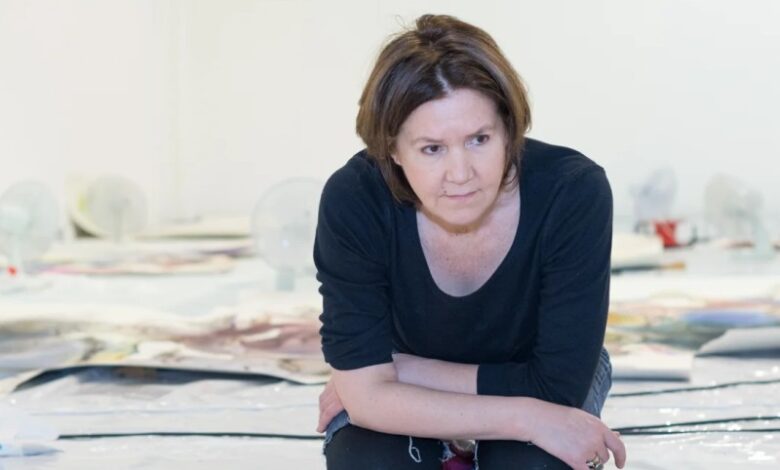Barbara Nicholls: The Visionary British Artist of Monumental Watercolour Landscapes

Among contemporary British artists, Barbara Nicholls stands out as a singular voice whose monumental watercolour paintings capture the deep and layered essence of natural landscapes. Born in Cheshire in 1963, Nicholls has carved out a remarkable career that bridges memory, geology, and material exploration. Her work goes beyond traditional watercolour painting, transforming the medium into something vast, immersive, and evocative. This article explores her life, artistic journey, unique techniques, exhibitions, and the lasting impact of her practice.
Early Life and Education
A Cheshire Beginning
Barbara Nicholls was born and raised in Cheshire, an area with rich geological features, rivers, and natural expanses that would later shape her artistic imagination. The surrounding environment—its rivers, canals, and cliffs—became an embedded source of inspiration. From a young age, Nicholls displayed a keen interest in observing natural forms and their constant transformations.
Academic Path
Her formal education in the arts began at Goldsmiths College, University of London, where she studied Fine Art from 1983 to 1986. She later completed her MA in Fine Art at the University of East London, followed by a Doctorate in Fine Art at the same institution. This long academic trajectory not only refined her technical skill but also gave her space to explore concepts of memory, material behaviour, and landscape in greater depth.
Barbara Nicholls as an Artist
A Unique Voice in Contemporary Watercolour
While many artists might see watercolour as a medium for small-scale, delicate works, Barbara Nicholls expanded its potential into something monumental. Her paintings are often vast sheets of paper laid on the floor, where she allows pigment, water, and gravity to interact in a semi-performative process.
This approach results in works that evoke sedimentary layers, tide marks, riverbeds, cliffs, and clouds. They are not direct depictions of places, but instead abstract formations that carry the memory of landscape.
Influences and Themes
At the heart of her practice lies a fascination with geology and natural history. Nicholls translates these phenomena into layered fields of colour and fluid marks. Her works suggest time, erosion, and the passage of natural forces. She draws upon her own memories of walking along rivers, canals, and geological sites in Britain and abroad, embedding personal resonance into universal imagery.
Artistic Techniques and Process
Working with Water and Pigment
Barbara Nicholls begins her process by laying paper flat on the studio floor. She pours water and applies pigments, then manipulates the flow using gravity, tilting the paper, or moving it with fans. As the water evaporates, layers of pigment settle in tide-like marks that resemble sediment or geological strata.
A Performative Practice
The making of each painting is both physical and performative. Nicholls interacts with her materials in real time, responding to their unpredictable behaviours. This practice allows her to embrace chance while still guiding the final composition.
Monumental Scale
Many of her works are on a scale that envelops the viewer, turning the act of looking into an immersive experience. The size of the paintings is not merely aesthetic but reflects her interest in geological and natural immensity—how landscapes can dwarf human presence.
Major Exhibitions and Recognition
Solo Exhibitions
Nicholls has presented numerous solo exhibitions across the UK and internationally. Some of the most notable include:
-
Between the Tides at Patrick Heide Contemporary Art, London (2025).
-
Sedimentary Flow at The Turnpike, Leigh (2019).
-
Solo presentations at Windermere Jetty Museum and Aleph Contemporary London (2020–2022).
These exhibitions highlight her ability to consistently reimagine watercolour as both a traditional and innovative medium.
Group Shows and International Recognition
Her work has also featured in group exhibitions in Germany, Australia, and the Netherlands, with institutions such as The New Art Gallery Walsall and Museum Kurhaus Kleve recognising her contribution to contemporary abstraction.
Residencies
Nicholls has undertaken residencies worldwide, which have further deepened her exploration of natural environments. Highlights include:
-
Stiftung Insel Hombroich, Germany (2024)
-
Kunst in Weidingen, Germany (2016–2021)
-
Lake Mungo, Australia (2016)
-
British Council residency in Brazil (1994)
These experiences allowed her to absorb different landscapes and geological histories, translating them into her unique visual vocabulary.
Barbara Nicholls in Collections
Her paintings are held in several important public and private collections. Institutions such as Museum Kurhaus Kleve, Kaiser Wilhelm Museum, and The New Art Gallery Walsall have acquired her works. This recognition places her firmly within the canon of contemporary British painting and ensures her legacy for future generations.
Critical Reception
Critical Voices
Art critics have often remarked on the meditative and immersive qualities of Nicholls’s paintings. Martin Holman, an established writer on contemporary art, has noted that her works touch “collective memories of the experience of natural spaces” and construct “a new reality” through their unique handling of material and form.
Audience Experience
For viewers, standing before a Barbara Nicholls painting can feel like confronting the vastness of nature itself. The works resonate with feelings of awe, tranquillity, and timelessness, encouraging contemplation and connection to the natural world.
Barbara Nicholls: The Artist’s Role Today
Sustainability and the Natural World
In an era of climate change and environmental awareness, Nicholls’s work gains renewed relevance. Though not overtly activist, her paintings remind us of the fragility and power of natural processes. By evoking rivers, sediments, and geological time, she highlights the forces shaping our world and underscores humanity’s relationship with nature.
Mentoring and Influence
Beyond her painting practice, Barbara Nicholls has also contributed to the artistic community through mentoring and teaching. She encourages younger artists to experiment with materiality, embrace process, and explore themes rooted in personal and collective memory.
Legacy and Importance
Barbara Nicholls’s career demonstrates how a single medium—watercolour—can be transformed into something entirely fresh and monumental. She has shifted perceptions of watercolour painting, proving that it can be bold, large-scale, and conceptually rich.
Her works straddle abstraction and landscape, memory and geology, offering viewers an emotional and intellectual experience. For contemporary British art, she stands as an important figure who pushes boundaries while staying deeply rooted in the natural world.
Conclusion
Barbara Nicholls is not simply a watercolour artist; she is a storyteller of the earth’s memory, a painter of geological time, and a performer of material behaviour. Her works are monumental not only in scale but in impact, resonating with audiences across continents. Through her process-driven approach, she has elevated watercolour into a medium of grandeur, contemplation, and profound connection to the natural environment.
As she continues to exhibit internationally and inspire new audiences, Barbara Nicholls remains a powerful figure in the dialogue between art, nature, and human perception. Her paintings remind us that landscapes are not just external spaces but also internal ones—deeply etched into memory, imagination, and collective experience.



